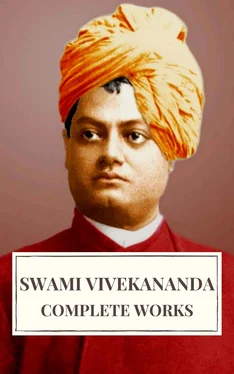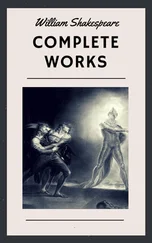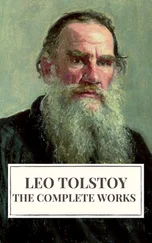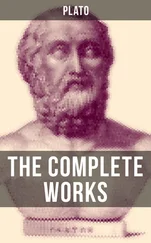Chapter VIII. Raja-Yoga In Brief
The following is a summary of Râja-Yoga freely translated from the Kurma-Purâna.
The fire of Yoga burns the cage of sin that is around a man. Knowledge becomes purified and Nirvâna is directly obtained. From Yoga comes knowledge; knowledge again helps the Yogi. He who combines in himself both Yoga and knowledge, with him the Lord is pleased. Those that practice Mahâyoga, either once a day, or twice a day, or thrice, or always, know them to be gods. Yoga is divided into two parts. One is called Abhâva, and the other, Mahayoga. Where one’s self is meditated upon as zero, and bereft of quality, that is called Abhava. That in which one sees the self as full of bliss and bereft of all impurities, and one with God, is called Mahayoga. The Yogi, by each one, realises his Self. The other Yogas that we read and hear of, do not deserve to be ranked with the excellent Mahayoga in which the Yogi finds himself and the whole universe as God. This is the highest of all Yogas.
Yama, Niyama, Âsana, Prânâyâma, Pratyâhâra, Dhârâna, Dhyâna, and Samâdhi are the steps in Raja-Yoga, of which non-injury, truthfulness, non-covetousness, chastity, not receiving anything from another are called Yama. This purifies the mind, the Chitta. Never producing pain by thought, word, and deed, in any living being, is what is called Ahimsâ, non-injury. There is no virtue higher than non-injury. There is no happiness higher than what a man obtains by this attitude of non-offensiveness, to all creation. By truth we attain fruits of work. Through truth everything is attained. In truth everything is established. Relating facts as they are — this is truth. Not taking others’ goods by stealth or by force, is called Asteya, non-covetousness. Chastity in thought, word, and deed, always, and in all conditions, is what is called Brahmacharya. Not receiving any present from anybody, even when one is suffering terribly, is what is called Aparigraha. The idea is, when a man receives a gift from another, his heart becomes impure, he becomes low, he loses his independence, he becomes bound and attached.
The following are helps to success in Yoga and are called Niyama or regular habits and observances; Tapas, austerity; Svâdhyâya, study; Santosha, contentment; Shaucha, purity; Ishvara-pranidhâna, worshipping God. Fasting, or in other ways controlling the body, is called physical Tapas. Repeating the Vedas and other Mantras, by which the Sattva material in the body is purified, is called study, Svadhyaya. There are three sorts of repetitions of these Mantras. One is called the verbal, another semi-verbal, and the third mental. The verbal or audible is the lowest, and the inaudible is the highest of all. The repetition which is loud is the verbal; the next one is where only the lips move, but no sound is heard. The inaudible repetition of the Mantra, accompanied with the thinking of its meaning, is called the “mental repetition,” and is the highest. The sages have said that there are two sorts of purification, external and internal. The purification of the body by water, earth, or other materials is the external purification, as bathing etc. Purification of the mind by truth, and by all the other virtues, is what is called internal purification. Both are necessary. It is not sufficient that a man should be internally pure and externally dirty. When both are not attainable the internal purity is the better, but no one will be a Yogi until he has both. Worship of God is by praise, by thought, by devotion.
We have spoken about Yama and Niyama. The next is Asana (posture). The only thing to understand about it is leaving the body free, holding the chest, shoulders, and head straight. Then comes Pranayama. Prana means the vital forces in one’s own body, Âyâma means controlling them. There are three sorts of Pranayama, the very simple, the middle, and the very high. Pranayama is divided into three parts: filling, restraining, and emptying. When you begin with twelve seconds it is the lowest Pranayama; when you begin with twenty-four seconds it is the middle Pranayama; that Pranayama is the best which begins with thirty-six seconds. In the lowest kind of Pranayama there is perspiration, in the medium kind, quivering of the body, and in the highest Pranayama levitation of the body and influx of great bliss. There is a Mantra called the Gâyatri. It is a very holy verse of the Vedas. “We meditate on the glory of that Being who has produced this universe; may He enlighten our minds.” Om is joined to it at the beginning and the end. In one Pranayama repeat three Gayatris. In all books they speak of Pranayama being divided into Rechaka (rejecting or exhaling), Puraka (inhaling), and Kurnbhaka (restraining, stationary). The Indriyas, the organs of the senses, are acting outwards and coming in contact with external objects. Bringing them under the control of the will is what is called Pratyahara or gathering towards oneself. Fixing the mind on the lotus of the heart, or on the centre of the head, is what is called Dharana. Limited to one spot, making that spot the base, a particular kind of mental waves rises; these are not swallowed up by other kinds of waves, but by degrees become prominent, while all the others recede and finally disappear. Next the multiplicity of these waves gives place to unity and one wave only is left in the mind. This is Dhyana, meditation. When no basis is necessary, when the whole of the mind has become one wave, one-formedness, it is called Samadhi. Bereft of all help from places and centres, only the meaning of the thought is present. If the mind can be fixed on the centre for twelve seconds it will be a Dharana, twelve such Dharanas will be a Dhyana, and twelve such Dhyanas will be a Samadhi.
Where there is fire, or in water or on ground which is strewn with dry leaves, where there are many ant-hills, where there are wild animals, or danger, where four streets meet, where there is too much noise, where there are many wicked persons, Yoga must not be practiced. This applies more particularly to India. Do not practice when the body feels very lazy or ill, or when the mind is very miserable and sorrowful. Go to a place which is well hidden, and where people do not come to disturb you. Do not choose dirty places. Rather choose beautiful scenery, or a room in your own house which is beautiful. When you practice, first salute all the ancient Yogis, and your own Guru, and God, and then begin.
Dhyana is spoken of, and a few examples are given of what to meditate upon. Sit straight, and look at the tip of your nose. Later on we shall come to know how that concentrates the mind, how by controlling the two optic nerves one advances a long way towards the control of the arc of reaction, and so to the control of the will. Here are a few specimens of meditation. Imagine a lotus upon the top of the head, several inches up, with virtue as its centre, and knowledge as its stalk. The eight petals of the lotus are the eight powers of the Yogi. Inside, the stamens and pistils are renunciation. If the Yogi refuses the external powers he will come to salvation. So the eight petals of the lotus are the eight powers, but the internal stamens and pistils are extreme renunciation, the renunciation of all these powers. Inside of that lotus think of the Golden One, the Almighty, the Intangible, He whose name is Om, the Inexpressible, surrounded with effulgent light. Meditate on that. Another meditation is given. Think of a space in your heart, and in the midst of that space think that a flame is burning. Think of that flame as your own soul and inside the flame is another effulgent light, and that is the Soul of your soul, God. Meditate upon that in the heart. Chastity, non-injury, forgiving even the greatest enemy, truth, faith in the Lord, these are all different Vrittis. Be not afraid if you are not perfect in all of these; work, they will come. He who has given up all attachment, all fear, and all anger, he whose whole soul has gone unto the Lord, he who has taken refuge in the Lord, whose heart has become purified, with whatsoever desire he comes to the Lord, He will grant that to him. Therefore worship Him through knowledge, love, or renunciation.
Читать дальше












